Ultrasound Evaluation of Therapeutic Response to Tofacitinib and Upadacitinib in Patients with Rheumatoid Arthritis—Real-Life Clinical Data
Abstract
1. Introduction
2. Materials and Methods
2.1. Design of the Study
2.2. Musculoskeletal Ultrasound
2.3. Statistical Analysis
3. Results
3.1. Patient Population
3.2. Disease Activity Scores
3.3. Echography Scores
3.4. Correlation Analysis
4. Discussion
5. Conclusions
Author Contributions
Funding
Institutional Review Board Statement
Informed Consent Statement
Data Availability Statement
Conflicts of Interest
Abbreviations
| ADR | adverse drug reaction |
| ACPA | anti-cyclic citrullinated peptide antibody |
| CDAI | clinical disease activity index |
| cs/b DMARDs | synthetic and/or biologic disease-modifying antirheumatic drugs |
| DAS28 | disease activity score |
| DAS28-CRP | disease activity score with C-reactive protein |
| DAS28-ESR | disease activity score with erythrocyte sedimentation rate |
| DMARD | disease-modifying antirheumatic drugs |
| EGA | evaluator global assessment of disease activity |
| EULAR | European Alliance of Associations for Rheumatology |
| HBV | hepatitis B virus |
| HCV | hepatitis C virus |
| GS | gray-scale |
| JAKi | Janus kinases inhibitors |
| LTB | interferon-gamma release assay for latent tuberculosis |
| MSUS | musculoskeletal ultrasonography |
| MTX | methotrexate |
| NHIF | National Health Insurance Fund |
| NYHA | New York Heart Association |
| OMERACT | Outcome Measures in Rheumatology |
| PD | power Doppler |
| PGA | patient global assessment of disease activity |
| RA | rheumatoid arthritis |
| RCT | randomized clinical trials |
| RF | rheumatoid factor |
| SDAI | simplified disease activity index |
| SH | synovial hypertrophy |
| SJC | swollen joint count |
| TJC | tender joint count |
| TOF | tofacitinib |
| USPD | ultrasound power Doppler |
| UPA | upadacitinib |
| US | ultrasound |
| USGS | ultrasound gray-scale |
Appendix A

Appendix B
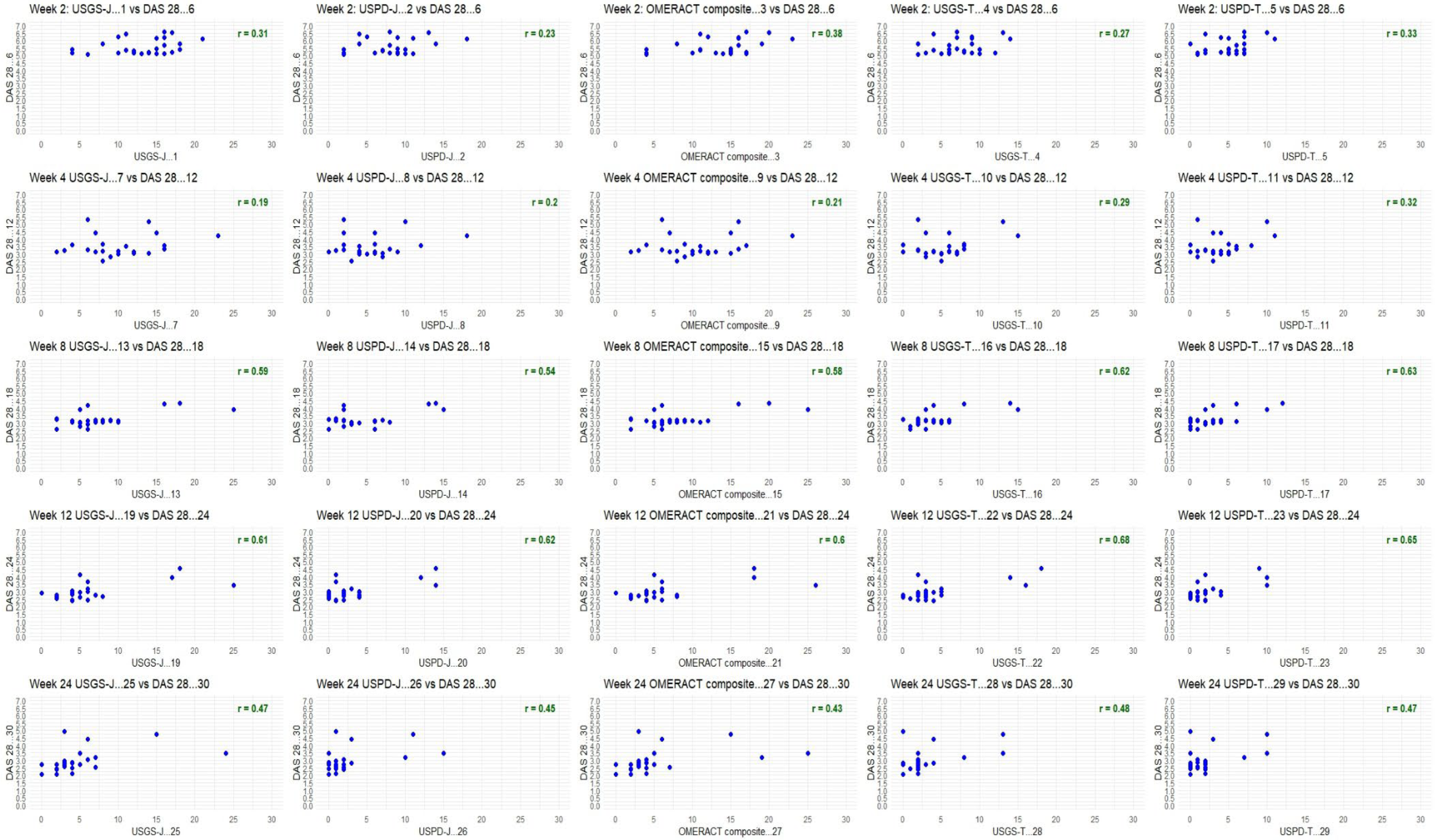
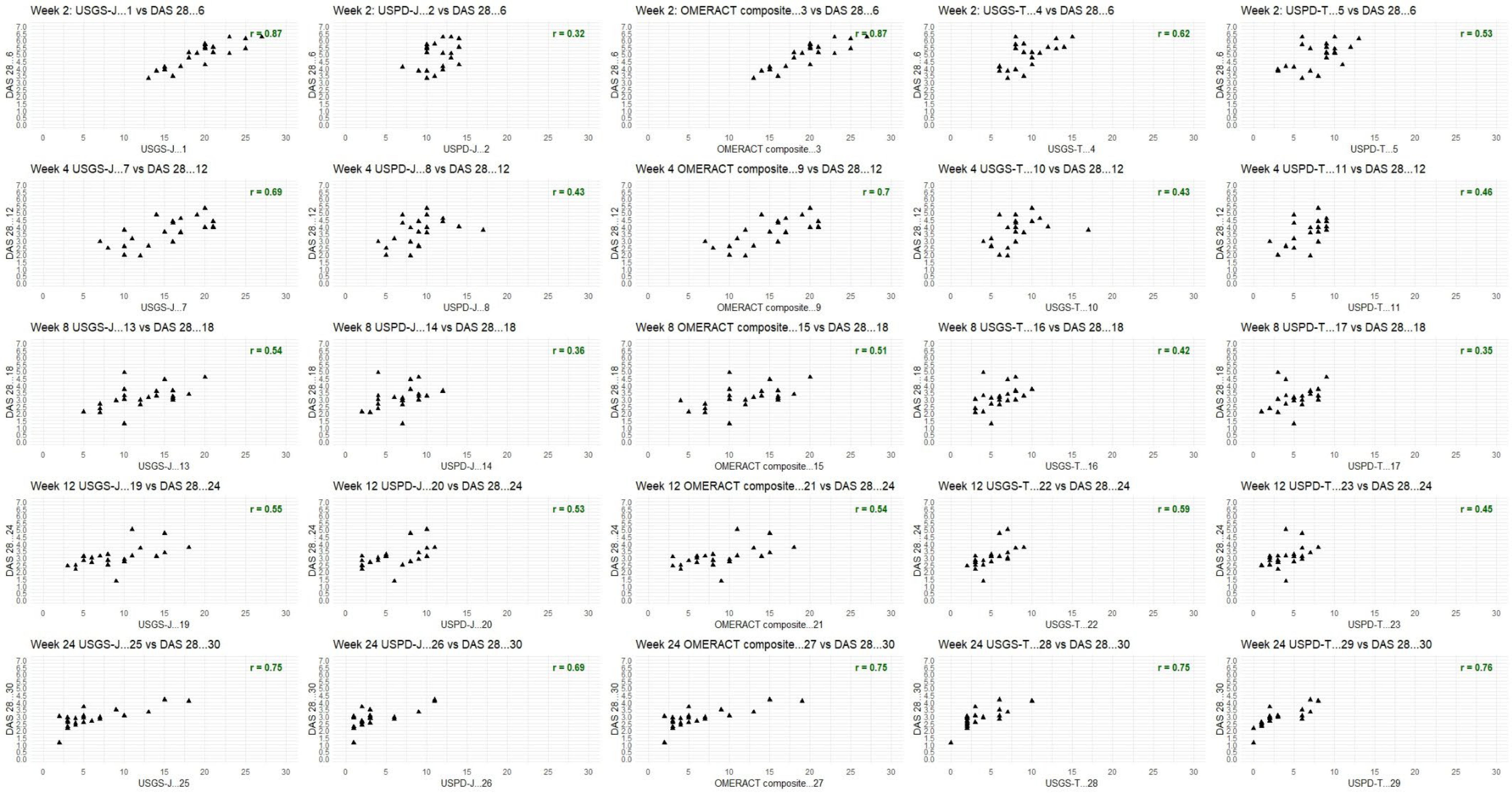

References
- Boyadzhieva, V.; Stoilov, N.; Ivanova, M.; Stoilov, R. Treatment of rheumatoid arthritis: csDMARDS versus bDMARDS. Prospective study to evaluate disease activity. Rheumatology 2019, 27, 3–15. [Google Scholar] [CrossRef]
- Boyadzhieva, V.; Stoilov, N.; Stoilov, R. Assessment of health-related quality of life in patients with rheumatoid arthritis and analysis of its change during csDMARDS and bDMARDS therapy after one year of follow-up. Rheumatology 2019, 27, 29–43. [Google Scholar] [CrossRef]
- Tachkov, K.; Boyadzhieva, V.; Stoilov, N.; Mitov, K.; Petrova, G. Is There a Symmetry in Disease Control and Quality of Life of Patients with Rheumatoid Arthritis Treated with Biological Therapy? Symmetry 2021, 13, 538. [Google Scholar] [CrossRef]
- Smolen, J.S.; Aletaha, D.; Bijlsma, J.W.J.; Breedveld, F.; Boumpas, D.; Burmester, G.; Combe, B.; Cutolo, M.; De Wit, M.; Dougados, M.; et al. Treating rheumatoid arthritis to target: Recommendations of an international task force. Ann. Rheum. Dis. 2010, 69, 631–637. [Google Scholar] [CrossRef]
- Singh, J.A.; Saag, K.G.; Bridges, S.L., Jr.; Akl, E.A.; Bannuru, R.R.; Sullivan, M.C.; Vaysbrot, E.; McNaughton, C.; Oscani, M.; Shmerling, R.H.; et al. 2015 American College of Rheumatology Guideline for the treatment of rheumatoid arthritis. Arthritis Rheumatol. 2016, 68, 1–26. [Google Scholar] [CrossRef]
- National Institute for Health and Clinical Excellence (NICE). 2 Rheumatoid Arthritis: The Management of Rheumatoid Arthritis in Adults; Royal College of Physicians: London, UK; National Collaborating Centre for Chronic Conditions: London, UK, 2009. [Google Scholar]
- van Vollenhoven, R. Treat-to-target in rheumatoid arthritis—Are we there yet? Nat. Rev. Rheumatol. 2019, 15, 180–186. [Google Scholar] [CrossRef]
- Wells, A.F.; Curtis, J.R.; Betts, K.A.; Douglas, K.; Du Xiaoyan, E.; Ganguli, A. Systematic literature review and meta-analysis of tumor necrosis factor-alpha experienced rheumatoid arthritis. Clin. Ther. 2017, 39, 1680–1694.e2. [Google Scholar] [CrossRef]
- Tracey, D.; Klareskog, L.; Sasso, E.H.; Salfeld, J.G.; Tak, P.P. Tumor necrosis factor antagonist mechanisms of action: A comprehensive review. Pharmacol. Ther. 2008, 117, 244–279. [Google Scholar] [CrossRef]
- Fleischmann, R.; Mysler, E.; Hall, S.; Kivitz, A.J.; Moots, R.J.; Luo, Z.; De Masi, R.; Soma, K.; Zhang, R.; Takiya, L.; et al. Efficacy and safety of tofacitinib monotherapy, tofacitinib with methotrexate, and adalimumab with methotrexate in patients with rheumatoid arthritis (ORAL Strategy): A phase 3b/4, double- blind, head-to-head, randomised controlled trial. Lancet 2017, 390, 457–468. [Google Scholar] [CrossRef]
- van der Heijde, D.; Strand, V.; Tanaka, Y.; Keystone, E.; Kremer, J.; Zerbini, C.A.F.; Cardiel, M.H.; Cohen, S.; Nash, P.; Song, Y.-W.; et al. Tofacitinib in combination with methotrexate in patients with rheumatoid arthritis: Clinical efficacy, radiographic, and safety outcomes from a twenty-four-month, phase III study. Arthritis Rheumatol. 2019, 71, 878–891. [Google Scholar] [CrossRef]
- Strand, V.; de Vlam, K.; Covarrubias-Cobos, J.A.; Mease, P.J.; Gladman, D.D.; Graham, D.; Wang, C.; Cappelleri, J.C.; Hendrikx, T.; Hsu, M.-A. Tofacitinib or adalimumab versus placebo: Patient-reported outcomes from OPAL Broaden-a phase III study of active psoriatic arthritis in patients with an inadequate response to conventional synthetic disease-modifying antirheumatic drugs. RMD Open 2019, 5, e000806. [Google Scholar] [CrossRef] [PubMed]
- Kavanaugh, A.; Kremer, J.; Ponce, L.; Cseuz, R.; Reshetko, O.V.; Stanislavchuk, M.; Greenwald, M.; Van der, A.A.; Vanhoutte, F.; Tasset, C.; et al. Filgotinib (GLPG0634/GS-6034), an oral selective JAK1 inhibitor, is effective as monotherapy in patients with active rheumatoid arthritis: Results from a randomised, dose-finding study (DARWIN 2). Ann. Rheum. Dis. 2017, 76, 1009–1019. [Google Scholar] [CrossRef] [PubMed]
- Genovese, M.C.; Kremer, J.; Zamani, O.; Ludivico, C.; Krogulec, M.; Xie, L.; Beattie, S.D.; Koch, A.E.; Cardillo, T.E.; Rooney, T.P.; et al. Baricitinib in patients with refractory rheumatoid arthritis. N. Engl. J. Med. 2016, 374, 1243–1252. [Google Scholar] [CrossRef] [PubMed]
- Genovese, M.C.; Fleischmann, R.; Combe, B.; Hall, S.; Rubbert-Roth, A.; Zhang, Y.; Zhao, Y.; Mohamed, M.-E.F.; Meerwein, S.; Pangan, A.L. Safety and efficacy of upadacitinib in patients with active rheumatoid arthritis refractory to biologic disease-modifying antirheumatic drugs (SELECT-BEYOND): A double-blind, randomised controlled phase 3 trial. Lancet 2018, 391, P2513–P2524. [Google Scholar] [CrossRef]
- Burmester, G.R.; Kremer, J.M.; Van den Bosch, F.; Kivitz, A.; Bessette, L.; Li, Y.; Zhou, Y.; Othman, A.A.; Pangan, A.L.; Camp, H.S. Safety and efficacy of upadacitinib in patients with rheumatoid arthritis and inadequate response to conventional synthetic disease-modifying anti-rheumatic drugs (SELECT-NEXT): A randomised, double-blind, placebo-controlled phase 3 trial. Lancet 2018, 391, 2503–2512. [Google Scholar] [CrossRef]
- Märker-Hermann, E.; Nitschmann, S. Upadacitinib bei Patienten mit rheumatoider Arthritis: SELECT-NEXT und SELECT-BEYOND. (Upadacitinib in patients with rheumatoid arthritis: SELECT-NEXT and SELECT-BEYOND). Internist 2019, 60, 549–552. [Google Scholar] [CrossRef] [PubMed]
- Smolen, J.S.; Pangan, A.L.; Emery, P.; Rigby, W.; Tanaka, Y.; Vargas, J.I.; Zhang, Y.; Damjanov, N.; Friedman, A.; Othman, A.A.; et al. Upadacitinib as monotherapy in patients with active rheumatoid arthritis and inadequate response to methotrexate (SELECT-MONOTHERAPY): A randomised, placebo-controlled, double-blind phase 3 study. Lancet 2019, 393, 2303–2311, Erratum in Lancet 2019, 393, 2590. [Google Scholar] [CrossRef]
- Germanò, G.; Macchioni, P.; Maranini, B.; Ciancio, G.; Bonazza, S.; Govoni, M.; Salvarani, C. Ultrasound response to tofacitinib in patients with rheumatoid arthritis: Data from a multicenter 24 weeks prospective study. Front. Med. 2022, 9, 990317. [Google Scholar] [CrossRef]
- Fleischmann, R.M.; Genovese, M.C.; Enejosa, J.V.; Mysler, E.; Bessette, L.; Peterfy, C.; Durez, P.; Ostor, A.; Li, Y.; Song, I.-H. Safety and effectiveness of upadacitinib or adalimumab plus methotrexate in patients with rheumatoid arthritis over 48 weeks with switch to alternate therapy in patients with insufficient response. Ann. Rheum. Dis. 2019, 78, 1454–1462. [Google Scholar] [CrossRef]
- The DAS28 Score. Available online: https://nras.org.uk/resource/the-das28-score/ (accessed on 15 January 2021).
- Prevoo, M.L.; van’t Hof, M.A.; Kuper, H.H.; van Leeuwen, M.A.; van de Putte, L.B.; van Riel, P.L. Modified disease activity scores that include twenty-eight–joint counts: Development and validation in a prospective longitudinal study of patients with rheumatoid arthritis. Arthritis Rheum. 1995, 38, 44–48. [Google Scholar] [CrossRef]
- Smolen, J.S.; Breedveld, F.C.; Schiff, M.H.; Kalden, J.R.; Emery, P.; Eberl, G.; van Riel, P.L.; Tugwell, P. A simplified disease activity index for rheumatoid arthritis for use in clinical practice. Rheumatology 2003, 42, 244–257. [Google Scholar] [CrossRef] [PubMed]
- Kremer, J.; Li, Z.G.; Hall, S.; Fleischmann, R.; Genovese, M.; Martin-Mola, E.; Isaacs, J.D.; Gruben, D.; Wallenstein, G.; Krishnaswami, S.; et al. Tofacitinib in combination with nonbiologic disease-modifying antirheumatic drugs in patients with active rheumatoid arthritis: A randomized trial. Ann. Intern. Med. 2013, 159, 253–261. [Google Scholar] [CrossRef] [PubMed]
- Terslev, L.; Naredo, E.; Aegerter, P.; Wakefield, R.J.; Backhaus, M.; Balint, P.; Bruyn, G.A.; Filippucci, E.; Grassi, W.; Lagnocco, A.; et al. Scoring ultrasound synovitis in rheumatoid arthritis: A EULAR OMERACT ultrasound taskforce-Part 2: Reliability and application to multiple joints of a standardised consensus-based scoring system. RMD Open 2017, 3, e000427. [Google Scholar] [CrossRef]
- Razmjou, A.A.; Brook, J.; Elashoff, D.; Kaeley, G.; Choi, S.; Kermani, T.; Ranganath, V.K. Ultrasound and multi-biomarker disease activity score for assessing and predicting clinical response to tofacitinib treatment in patients with rheumatoid arthritis. BMC Rheumatol. 2020, 4, 55. [Google Scholar] [CrossRef]
- Di Matteo, A.; Mankia, K.; Azukizawa, M.; Wakefield, R.J. The Role of Musculoskeletal Ultrasound in the Rheumatoid Arthritis Continuum. Curr. Rheumatol. Rep. 2020, 22, 41. [Google Scholar] [CrossRef] [PubMed]
- Elangovan, S.; Kiat Tan, Y. The Role of Musculoskeletal Ultrasound Imaging in Rheumatoid Arthritis. Ultrasound Med. Biol. 2020, 46, 1841–1853. [Google Scholar] [CrossRef]
- Felson, D.T.; Smolen, J.S.; Wells, G.; Zhang, B.; van Tuyl, L.H.; Funovits, J.; Aletaha, D.; Allaart, C.F.; Bathon, J.; Bombardieri, S.; et al. American college of rheumatology/European league against rheumatism provisional definition of remission in rheumatoid arthritis for clinical trials. Ann. Rheum. Dis. 2011, 70, 404–413. [Google Scholar] [CrossRef] [PubMed]
- Kgoebane, K.; Ally, M.M.T.M.; Duim-Beytell, M.C.; Suleman, F.E. The role of imaging in rheumatoid arthritis. SA J. Radiol. 2018, 22, 1316. [Google Scholar] [CrossRef] [PubMed] [PubMed Central]
- National Council of Prices and Reimbursement of Medicines. Pharmacotherapeutic Guideline on Rheumatology. Available online: https://www.ncpr.bg/images/farmako-terapevtichni/2019/01.04.2019/ftr_po_revmatologiia.pdf (accessed on 14 May 2025).
- National Health Insurance Fund. Requirements for Rheumatology. Available online: https://www.nhif.bg/upload/22768/18.%D0%98%D0%B7%D0%B8%D1%81%D0%BA%D0%B2%D0%B0%D0%BD%D0%B8%D1%8F%20%D0%BD%D0%B0%20%D0%9D%D0%97%D0%9E%D0%9A%20%20%D1%80%D0%B5%D0%B2%D0%BC%D0%B0%D1%82%D0%BE%D0%BB%D0%BE%D0%B3%D0%B8%D1%8F.pdf (accessed on 14 May 2025).
- Aletaha, D.; Smolen, J.S. Diagnosis and management of rheumatoid arthritis: A review. JAMA 2018, 320, 1360–1372. [Google Scholar] [CrossRef]
- Sanmartí, R.; Corominas, H. Upadacitinib for Patients with Rheumatoid Arthritis: A Comprehensive Review. J. Clin. Med. 2023, 12, 1734. [Google Scholar] [CrossRef] [PubMed] [PubMed Central]
- Harrington, R.; Al Nokhatha, S.A.; Conway, R. JAK Inhibitors in Rheumatoid Arthritis: An Evidence-Based Review on the Emerging Clinical Data. J. Inflamm. Res. 2020, 13, 519–531. [Google Scholar] [CrossRef] [PubMed] [PubMed Central]
- van Vollenhoven, R.; Takeuchi, T.; Pangan, A.L.; Friedman, A.; Mohamed, M.F.; Chen, S.; Rischmueller, M.; Blanco, R.; Xavier, R.M.; Strand, V. Efficacy and safety of upadacitinib monotherapy in methotrexate-naïve patients with moderately to severely active rheumatoid arthritis (SELECT-EARLY): A randomized, double-blind, active-comparator, multi-center, multi-country trial. Arthritis Rheumatol. 2020, 72, 1607–1620. [Google Scholar] [CrossRef]
- Rubbert-Roth, A.; Enejosa, J.; Pangan, A.L.; Haraoui, B.; Rischmueller, M.; Khan, N.; Zhang, Y.; Martin, N.; Xavier, R.M. Trial of Upadacitinib or Abatacept in Rheumatoid Arthritis. N. Engl. J. Med. 2020, 383, 1511–1521. [Google Scholar] [CrossRef]
- Rubbert-Roth, A.; Enejosa, J.; Pangan, A.; Xavier, R.; Haraoui, B.; Rischmueller, M.; Khan, N.; Zhang, Y.; Martin, N.; Genovese, M.C. Efficacy and safety of upadacitinib versus abatacept in patients with active rheumatoid arthritis and prior inadequate response or intolerance to biologic disease-modifying anti-rheumatic drugs (SELECT-CHOICE): A double-blind, rnadomized controlled Phase 3 trial. Ann. Rheum. Dis. 2020, 79, 1011. [Google Scholar]
- Fleischmann, R.; Mease, P.J.; Schwartzman, S.; Hwang, L.J.; Soma, K.; Connell, C.A.; Takiya, L.; Bananis, E. Efficacy of tofacitinib in patients with rheumatoid arthritis stratified by background methotrexate dose group. Clin. Rheum. 2017, 36, 15–24. [Google Scholar] [CrossRef]
- Aletaha, D.; Alasti, F.; Smolen, J.S. Rituximab dissociates the tight link between disease activity and joint damage in rheumatoid arthritis patients. Ann. Rheum. Dis. 2013, 72, 7–12. [Google Scholar] [CrossRef] [PubMed]
- Lee, E.; Fleischmann, R.; Hall, S.; Wilkinson, B.; Bradley, J.D.; Gruben, D.; Koncz, T.; Krishaswami, S.; Wallenstein, G.V.; Zang, C.; et al. Tofacitinib versus methotrexate in rheumatoid arthritis. N. Engl. J. Med. 2014, 370, 2377–2386. [Google Scholar] [CrossRef] [PubMed]
- Fleischmann, R.; Pangan, A.L.; Mysler, E.; Bessette, L.; Peterfy, C.; Durez, P.; Ostor, A.J.; Li, Y.; Zhao, Y.; Othman, A.; et al. A phase 3, randomized, double-blind study comparing upadacitinib to placebo and to adalimumab, in patients with active rheumatoid arthritis with inadequate response to methotrexate. Arthritis Rheumatol. 2018, 70 (Suppl. S10), 1788–1800. [Google Scholar]
- Hameed, B.; Pilcher, J.; Heron, C.; Kiely, P.D. The relation between composite ultrasound measures and the DAS28 score, its components and acute phase markers in adult RA. Rheumatology 2008, 47, 476–480. [Google Scholar] [CrossRef] [PubMed]
- Baldi, C.; Parisi, S.; Falsetti, P.; Sota, J.; Ditto, M.C.; Capassoni, M.; D’alessandro, M.; Conticini, E.; Nacci, F.; Peroni, C.L.; et al. Efficacy and Safety of Upadacitinib in Rheumatoid Arthritis: Real-Life Experience from a Prospective Longitudinal Multicentric Study. J. Clin. Med. 2024, 13, 401. [Google Scholar] [CrossRef]
- Picchianti Diamanti, A.; Cattaruzza, M.S.; Salemi, S.; De Rosa, R.; Sesti, G.; De Lorenco, C.; Felice, G.M.; Fediani, B.; Baldi, C.; Chimenti, M.S.; et al. Clinical and Ultrasonographic Remission in Bio-naïve and Bio-failure Patients with Rheumatoid Arthritis at 24 Weeks of Upadacitinib Treatment: The UPARAREMUS Real-Life Study. Rheumatol. Ther. 2024, 11, 1347–1361. [Google Scholar] [CrossRef] [PubMed]
- Ceccarelli, F.; Spinelli, F.R.; Garufi, C.; Mancuso, S.; Alessandri, C.; Di Franco, M.; Orefice, V.; Pacucci, V.A.; Pirone, C.; Priori, R.; et al. The role of musculoskeletal ultrasound in predicting the response to JAK inhibitors: Results from a monocentric cohort. Clin. Exp. Rheumatol. 2022, 40, 921–927. [Google Scholar] [CrossRef] [PubMed]
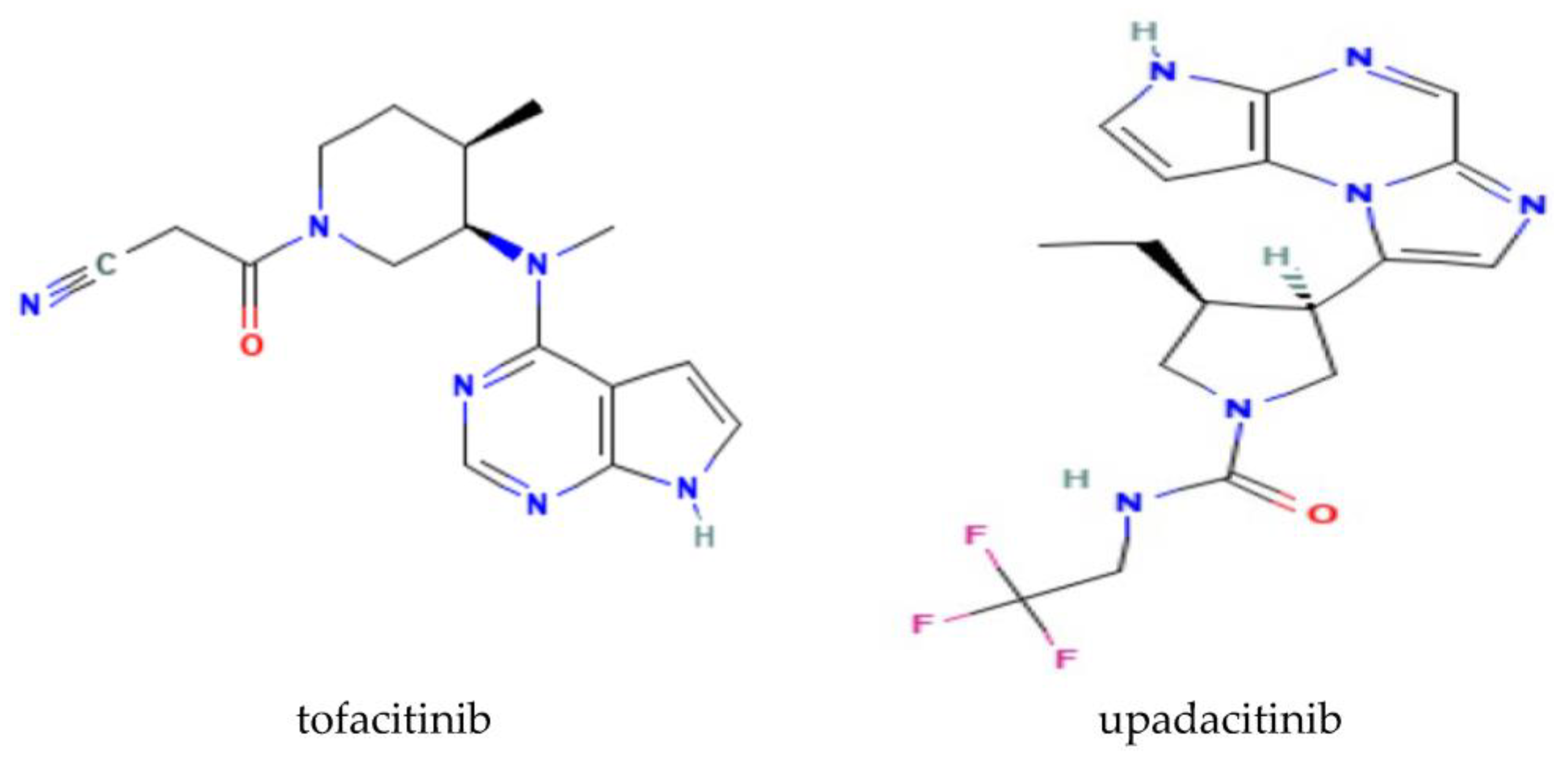
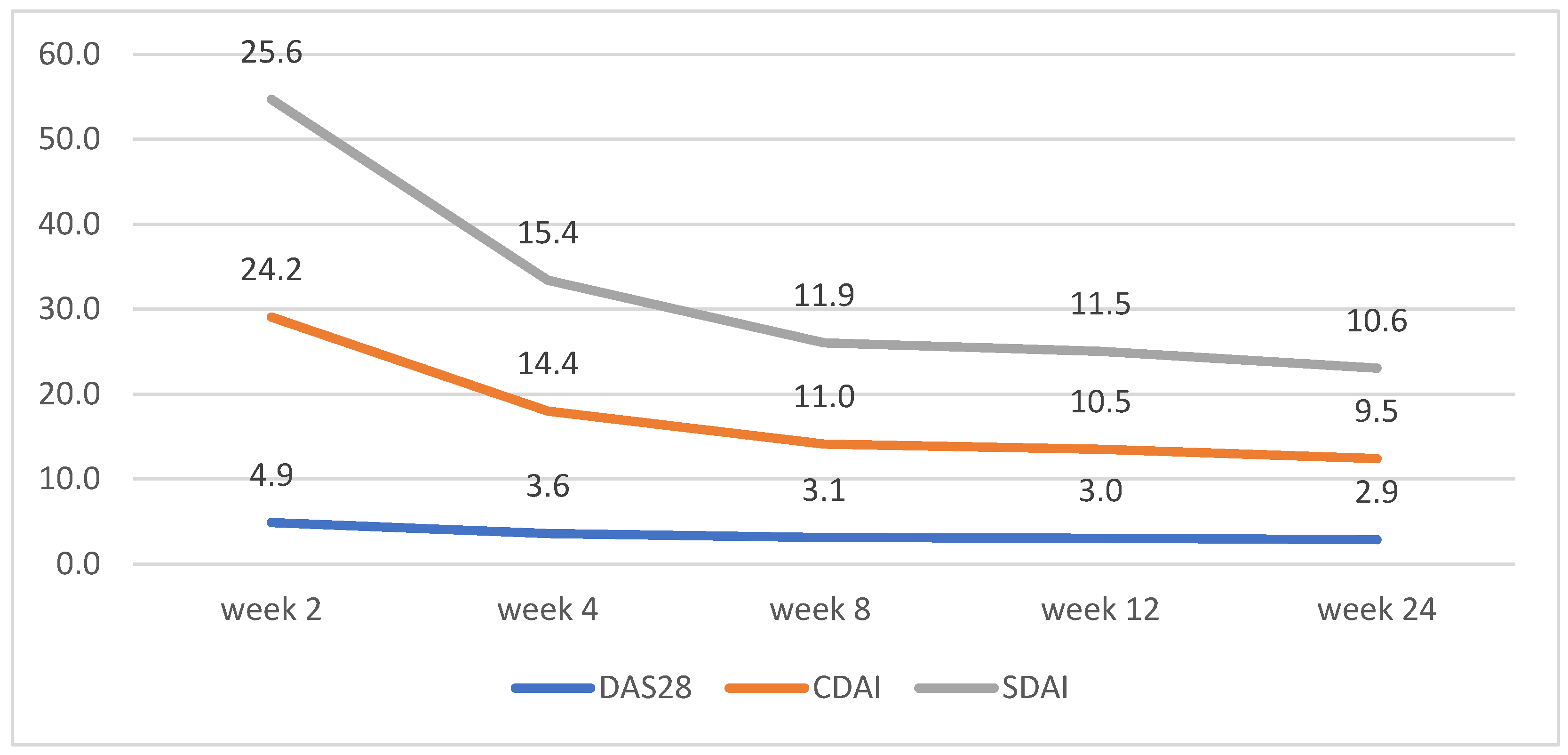
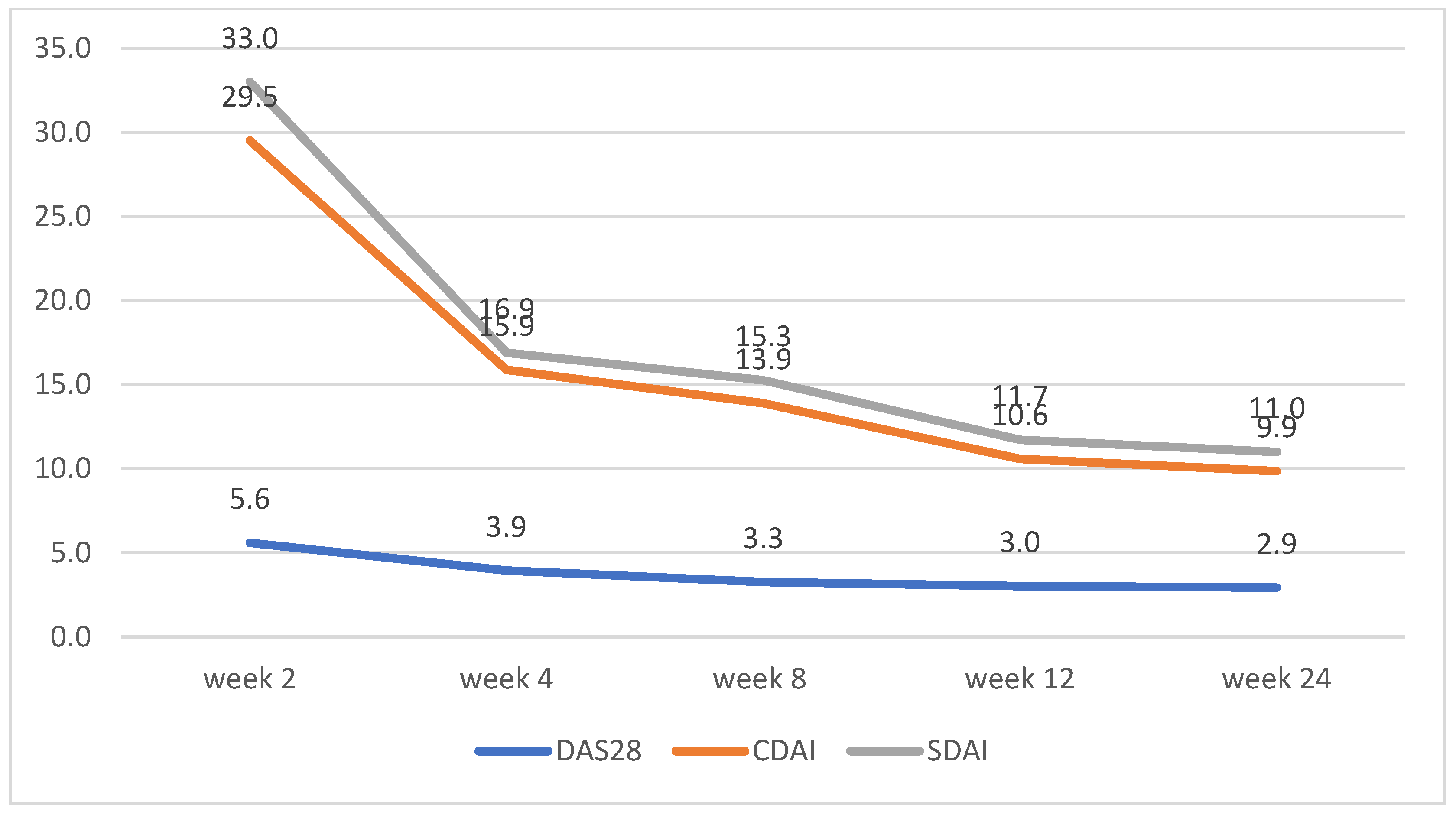

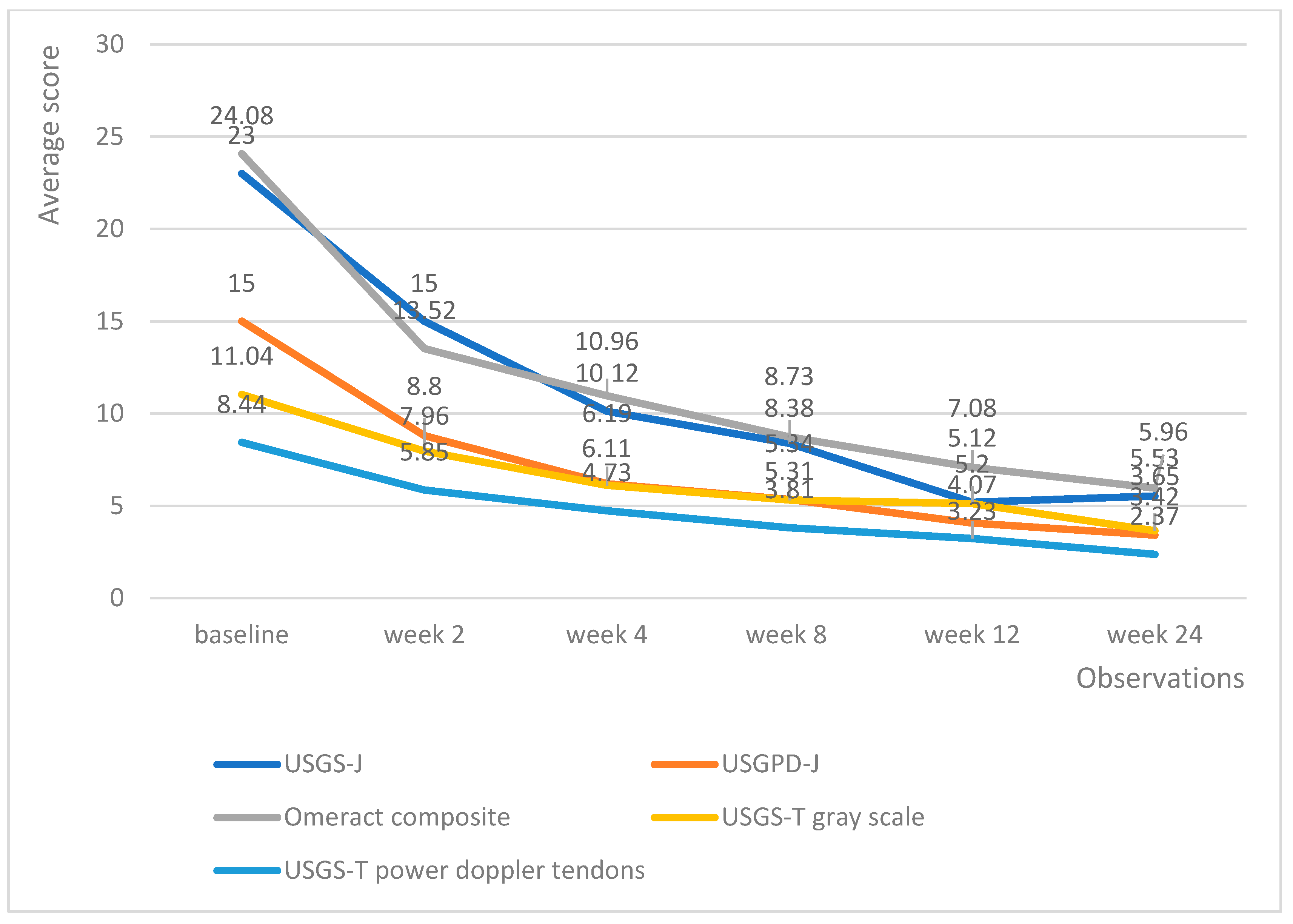

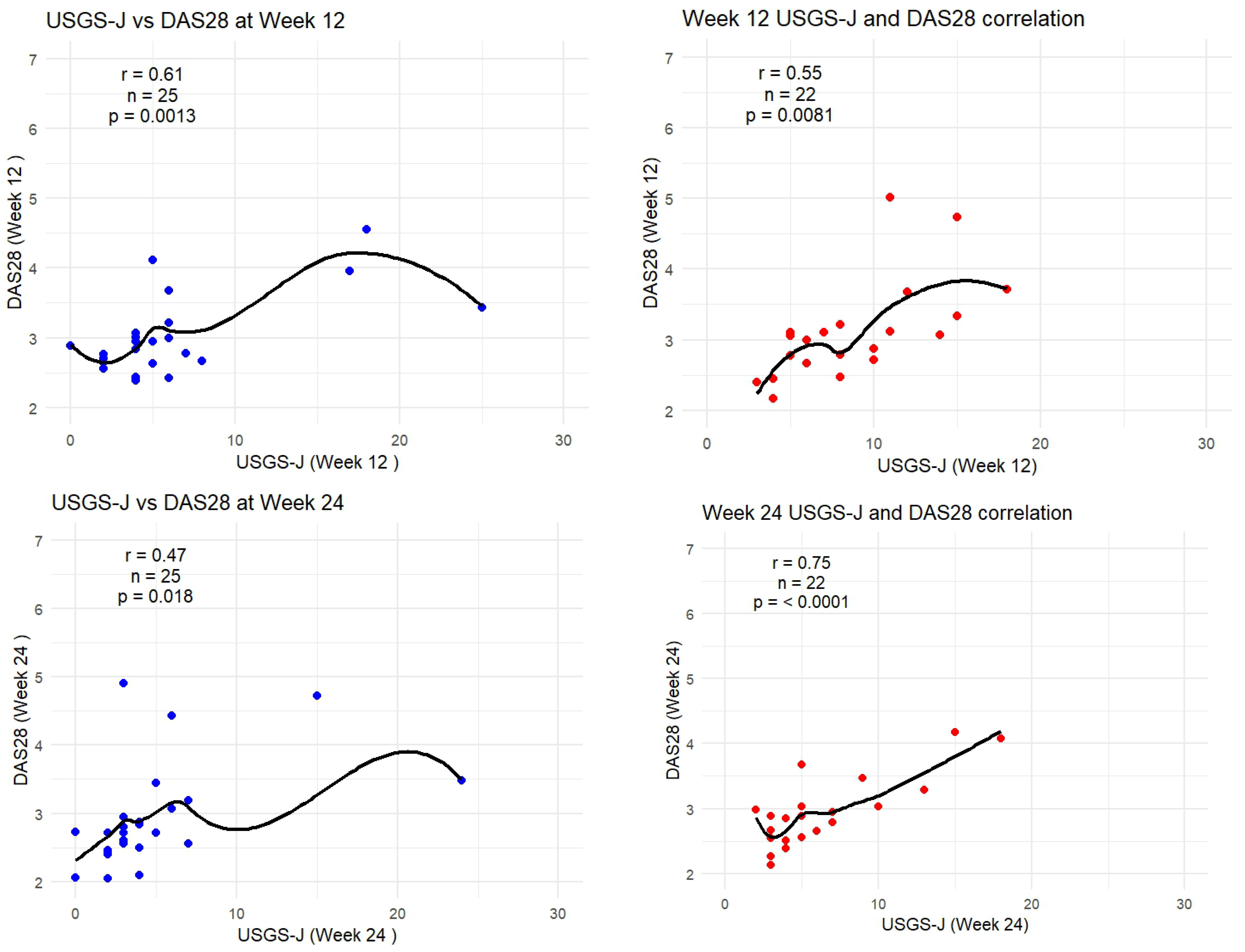
| Demographic Characteristics | Upadacitinib | Tofacitinib |
|---|---|---|
| Male | 5 | 4 |
| Female | 20 | 18 |
| Age | 56 ± 11.6 SD | 56.9 ± 11.3 SD |
| Duration of disease | 8.24 ± 4.92 SD | 11.17 ± 7.5 SD |
| Total Number of patients | 25 | 22 |
| OMERACT Composite | USGS-J | USPD-T | USPD-J | USGT-T | ||||||
|---|---|---|---|---|---|---|---|---|---|---|
| Drug | tofa | upa | tofa | Upa | tofa | upa | tofa | upa | tofa | upa |
| N | 22 | 25 | 22 | 25 | 22 | 25 | 22 | 25 | 22 | 25 |
| Mean | 23.4 | 24 | 23 | 23 | 9.54 | 8.44 | 13.36 | 15 | 12.18 | 11.04 |
| 95% CI | 21.2–25.5 | 22.4–25.7 | 21.0–24.9 | 21.4–24.5 | 8.4–10.59 | 7.4–9.4 | 12.4–14.2 | 13.7–16.2 | 11.1–13.2 | 9.88–12.1 |
| Variances | 23.01 | 16.57 | 20.19 | 13.33 | 5.59 | 5.92 | 4.05 | 9.00 | 5.67 | 7.87 |
| SD | 4.7 | 4.07 | 4.49 | 3.65 | 2.36 | 2.43 | 2.01 | 3.0 | 2.38 | 2.80 |
| Median | 23.50 | 24.00 | 23.0 | 23.0 | 10.0 | 8.000 | 13.50 | 16.00 | 12.0 | 11.00 |
| 95% CI | 19.9–26.0 | 22.0–25.8 | 19.9–25.04 | 21.0–25.0 | 8.00–10.05 | 7.00–9.00 | 12.00–15.0 | 13.0–17.0 | 10.0–14.0 | 10.0–12.86 |
| Minimum | 16.00 | 18.00 | 16.00 | 16.0 | 5.000 | 4.0 | 10.0 | 8.000 | 8.000 | 6.000 |
| Maximum | 35.0 | 32.0 | 33.0 | 30.0 | 14.00 | 17.00 | 16.0 | 20.0 | 16.0 | 16.0 |
| 25–75p | 19–26 | 21–27.2 | 19–26 | 20.7–26 | 8–11 | 7–9 | 12–15 | 12.7–17 | 10–14 | 8.7–13 |
| DAS28 | |||||
|---|---|---|---|---|---|
| Upadacitinib | WEEK 2 | WEEK 4 | WEEK 8 | WEEK 12 | WEEK 24 |
| Average | 5.5932 | 3.4904 | 3.2552 | 3.0152 | 2.93 |
| Standard deviation | 0.5081 | 0.4805 | 0.4734 | 0.5344 | 0.759 |
| Tofacitinib | WEEK 2 | WEEK 4 | WEEK 8 | WEEK 12 | WEEK 24 |
| Average | 4.8705 | 3.5964 | 3.1191 | 3.0345 | 2.8591 |
| Standard deviation | 0.9134 | 0.9453 | 0.8357 | 0.7866 | 0.6574 |
| CDAI | |||||
| Upadacitinib | WEEK 2 | WEEK 4 | WEEK 8 | WEEK 12 | WEEK 24 |
| Average | 29.52 | 15.884 | 13.8956 | 10.5784 | 9.8536 |
| Standard deviation | 5.7783 | 6.2021 | 4.8695 | 5.6715 | 7.1093 |
| Tofacitinib | WEEK 2 | WEEK 4 | WEEK 8 | WEEK 12 | WEEK 24 |
| Average | 24.1864 | 14.3818 | 10.9864 | 10.4773 | 9.5473 |
| Standard deviation | 5.7063 | 7.1046 | 5.528 | 4.7828 | 3.9626 |
| SDAI | |||||
| Upadacitinib | WEEK 2 | WEEK 4 | WEEK 8 | WEEK 12 | WEEK 24 |
| Average | 33.0064 | 16.8944 | 15.264 | 11.72 | 10.9952 |
| Standard deviation | 6.6384 | 6.5034 | 5.6479 | 5.93 | 7.4371 |
| Tofacitinib | WEEK 2 | WEEK 4 | WEEK 8 | WEEK 12 | WEEK 24 |
| Average | 25.6241 | 15.4141 | 11.93 | 11.5109 | 10.6455 |
| Standard deviation | 6.1324 | 7.753 | 6.1275 | 5.3767 | 3.7905 |
| USGS-J | USPD-J | OMERACT Composite | USGS-T | USPD-T | ||
|---|---|---|---|---|---|---|
| DAS28 | Week 2 | No | No | No | No | No |
| Week 4 | No | No | No | No | No | |
| Week 8 | Yes p = 0.0019 | Yes p = 0.0049 | Yes p = 0.0022 | Yes p = 0.0010 | Yes p = 0.0007 | |
| Week 12 | Yes p = 0.0013 | Yes p = 0.0010 | Yes p = 0.0017 | Yes p = 0.0002 | Yes p = 0.0004 | |
| Week 24 | Yes p = 0.0180 | Yes p = 0.0241 | Yes p = 0.0321 | Yes p = 0.0145 | Yes p = 0.0174 | |
| CDAI | Week 2 | No | No | No | No | No |
| Week 4 | No | No | No | No | No | |
| Week 8 | Yes p = 0.0443 | No | No | Yes p = 0.0173 | Yes p = 0.0273 | |
| Week 12 | Yes p = 0.0249 | Yes p = 0.0314 | Yes p = 0.0282 | Yes p = 0.0188 | Yes p = 0.0146 | |
| Week 24 | Yes p = 0.0151 | Yes p = 0.0151 | Yes p = 0.0154 | Yes p = 0.0170 | Yes p = 0.0189 | |
| SDAI | Week 2 | No | No | No | No | No |
| Week 4 | No | No | No | No | No | |
| Week 8 | No | No | No | Yes p = 0.0280 | No | |
| Week 12 | Yes p = 0.0135 | Yes p = 0.0175 | Yes p = 0.0151 | Yes p = 0.0101 | Yes p = 0.0075 | |
| Week 24 | Yes p = 0.0084 | Yes p = 0.0099 | Yes p = 0.0105 | Yes p = 0.0078 | Yes p = 0.0075 |
| USGS-J | USPD-J | OMERACT Composite | USGS-T | USPD-T | ||
|---|---|---|---|---|---|---|
| DAS28 | Week 2 | Yes p < 0.0001 | Yes p = 0.0126 | Yes p < 0.0001 | Yes p = 0.0027 | Yes p = 0.0167 |
| Week 4 | Yes p = 0.0004 | Yes p = 0.0447 | Yes p = 0.0003 | Yes p = 0.0466 | Yes p = 0.0293 | |
| Week 8 | Yes p = 0.0098 | No | Yes p = 0.0146 | Yes p = 0.0535 | No | |
| Week 12 | Yes p = 0.0081 | Yes p = 0.0113 | Yes p = 0.0089 | Yes p = 0.0041 | Yes p = 0.0372 | |
| Week 24 | Yes p = 0.0001 | Yes p = 0.0004 | Yes p = 0.0001 | Yes p < 0.0001 | Yes p < 0.0001 | |
| CDAI | Week 2 | Yes p = 0.0002 | No | Yes p = 0.0002 | Yes p = 0.0163 | No |
| Week 4 | Yes p = 0.0052 | No | Yes p = 0.0032 | No | No | |
| Week 8 | No | No | No | Yes p = 0.0468 | No | |
| Week 12 | Yes p = 0.0093 | Yes p = 0.0242 | Yes p = 0.0182 | Yes p = 0.0065 | Yes p = 0.0114 | |
| Week 24 | Yes p = 0.0018 | Yes p = 0.0086 | Yes p = 0.0024 | Yes p = 0.0007 | Yes p = 0.0005 | |
| SDAI | Week 2 | Yes p = 0.0001 | No | Yes p = 0.0001 | Yes p = 0.0056 | Yes p = 0.0296 |
| Week 4 | Yes p = 0.0033 | No | Yes p = 0.0021 | Yes p = 0.0468 | No | |
| Week 8 | No | No | No | No | No | |
| Week 12 | Yes p = 0.0104 | Yes p = 0.0266 | Yes p = 0.0130 | Yes p = 0.0032 | No | |
| Week 24 | Yes p = 0.0012 | Yes p = 0.0083 | Yes p = 0.0014 | Yes p = 0.0003 | Yes p = 0.0007 |
Disclaimer/Publisher’s Note: The statements, opinions and data contained in all publications are solely those of the individual author(s) and contributor(s) and not of MDPI and/or the editor(s). MDPI and/or the editor(s) disclaim responsibility for any injury to people or property resulting from any ideas, methods, instructions or products referred to in the content. |
© 2025 by the authors. Licensee MDPI, Basel, Switzerland. This article is an open access article distributed under the terms and conditions of the Creative Commons Attribution (CC BY) license (https://creativecommons.org/licenses/by/4.0/).
Share and Cite
Boyadzhieva, V.; Tachkov, K.; Emin, S.; Apostolova, Z.; Stoilov, R.; Petrova, G.; Stoilov, N. Ultrasound Evaluation of Therapeutic Response to Tofacitinib and Upadacitinib in Patients with Rheumatoid Arthritis—Real-Life Clinical Data. Biomedicines 2025, 13, 1339. https://doi.org/10.3390/biomedicines13061339
Boyadzhieva V, Tachkov K, Emin S, Apostolova Z, Stoilov R, Petrova G, Stoilov N. Ultrasound Evaluation of Therapeutic Response to Tofacitinib and Upadacitinib in Patients with Rheumatoid Arthritis—Real-Life Clinical Data. Biomedicines. 2025; 13(6):1339. https://doi.org/10.3390/biomedicines13061339
Chicago/Turabian StyleBoyadzhieva, Vladimira, Konstantin Tachkov, Soner Emin, Zhaklin Apostolova, Rumen Stoilov, Guenka Petrova, and Nikolay Stoilov. 2025. "Ultrasound Evaluation of Therapeutic Response to Tofacitinib and Upadacitinib in Patients with Rheumatoid Arthritis—Real-Life Clinical Data" Biomedicines 13, no. 6: 1339. https://doi.org/10.3390/biomedicines13061339
APA StyleBoyadzhieva, V., Tachkov, K., Emin, S., Apostolova, Z., Stoilov, R., Petrova, G., & Stoilov, N. (2025). Ultrasound Evaluation of Therapeutic Response to Tofacitinib and Upadacitinib in Patients with Rheumatoid Arthritis—Real-Life Clinical Data. Biomedicines, 13(6), 1339. https://doi.org/10.3390/biomedicines13061339







